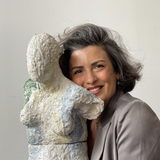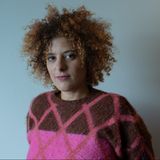The ‘Matter & Found Forms‘ workshop represented a moment to slow down the frenetic everyday life and spend a couple of hours between collective sharing, rapprochement with physical matter and viewing archaeological relics from which to draw inspiration. This, together with the artist and ceramic expert Esra Sakir.
The events, two so far but others will follow in 2024, were hosted in our New Metropolis Nieuw-West headquarters and were designed to reconnect with the earth, experience one’s creativity and consciously recognise one’s origins and (re)discover the technique of modelling clay. The art of ceramics is one of the oldest and most primitive human activities. Its processing is very profound, liberating, and offers immediate activation. This is because the manipulation of the clay allows – due to its elasticity and plasticity – not only the learning of techniques, but also to regain one’s own bodily perception. To enter in more profound contact with our manual skills and to reclaim a capacity that is inherent in human nature and is functional to the processing of personal experiences. You cannot manipulate clay without creating, and thanks to the journey made with the artist, every shape created speaks of us. In fact, during the process the artist Esra Sakir leads us to ask ourselves: “What are humanities first artistic expressive forms? What did they mean? What role did women have in primordial societies? How are these images of the past still related to our present?”
In the first part of the workshop, the artist Esra Sakir proposes a moment of reflection on the role played by women in the prehistory and protohistory of humanity through an interesting interpretation of the precious heritage of Paleolithic ‘Venuses’ or ‘Mother Goddesses’ found in the European area, North Africa and the Near East. In fact, female iconography represents, in parallel with rock paintings, the most ancient form of art and sacredness of humanity. It is a historical-anthropological element useful for shedding light on a part of history that is too often omitted, in which women have a fundamental role and a universally recognised sacredness.
In the second part of the workshop the act of creating has a strong symbolic value. During the practical manipulation activity, the knowledge shared by the artist in the first part is reworked and becomes suggestive. Esra Sakir leads the group in a creative and introspective process, aimed at the creation of personal artistic objects.
The ‘Matter & Found Forms’ workshop is an experiential clay manipulation laboratory which, using artistic language, aims to give answers to these questions but also to stimulate and enhance the role of women in contemporary societies. The objects developed were the most varied: sculptures, bas-reliefs, everyday objects in the field of furniture and tableware, vases, containers, objects deeply linked to life and survival, decorative panels, small sculptures. Creating forms of art never turns out to be an experience as an end in itself, but it is a stimulus for new ideas and sensations. This starts from the individual, from their corporeality, which comes into contact with the material with which they elaborate a form. It is an encounter with a material based on the senses and which, precisely for this reason, can move deep affections and experiences and activate a process of continuous and vital transformation.
The first two events of ‘Matter & Found Forms’ will be celebrated with a pop-up exhibition on 6 December 2023 in which all participants will show their works and will have the opportunity to exchange ideas with the artist and others about it. On the same evening we will have the music of 童心 Tongxin, another stimulus of a culture that can only have references of transversal origin.
Reserver your free spot here!








